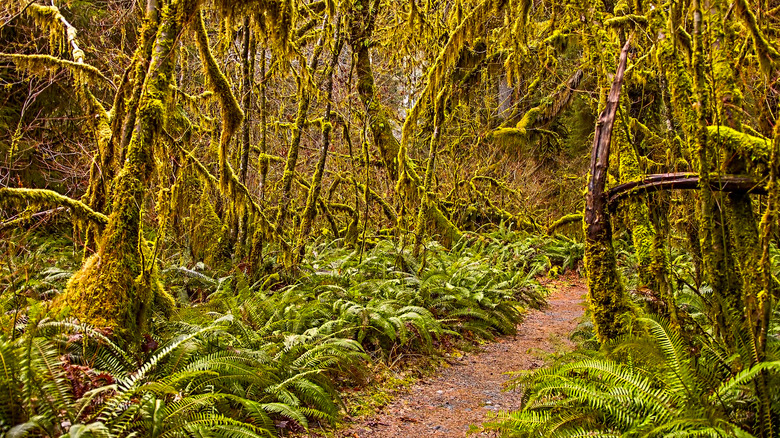What Are Some Abiotic Factors In A Temperate Rain Forest?
Temperate rain forests, as opposed to tropical rain forests, represent rare ecosystems that exist in the temperate zones of the world. Because of their higher latitudes, they are much cooler and darker than tropical rain forests. Temperate rain forests can be found along the northern Pacific coast of North America from Alaska to Oregon, the coast of Chile, New Zealand, the island of Tasmania, and parts of Japan, Norway, and Turkey. A number of abiotic factors, which are non-living factors influencing an ecosystem, whether chemical or physical, contribute to the unique characteristics of temperate rain forests.
TL;DR (Too Long; Didn't Read)
Several abiotic (non-living) factors affect temperate rain forest ecosystems. These include water, temperature, topography, light, wind and soil.
The Abiotic Factor of Water
The Abiotic Factor of Water
Because these forests are mostly found alongside oceans with comparatively warm currents, the chief defining abiotic factor that distinguishes temperate rain forests is water. Specifically, water in the form of precipitation determines what species thrive in this environment. Temperate rain forests receive between 150 to 500 centimeters (59 to 197 inches) of precipitation annually. Fog alone contributes to a significant amount of precipitation. In cooler temperate rain forests in higher latitudes, snowfall can occur.
The high prevalence of rain and snow contributes to tributary flows to the ocean. The increase in salinity near the ocean contributes to more marine aspects of part of these rain forests. The mix of freshwater sources with the sea creates a nutrient-rich environment for several species on land and in the water. Ocean currents also play a role in moderating sea temperatures, which in turn contributes to weather patterns that provide these forests with their abundant rainfall.
Temperature and Fire Risk
Temperature and Fire Risk
Temperature is another example of an abiotic factor in temperate rain forests. A temperate rain forest rarely drops below freezing, and likewise rarely exceeds temperatures above 80 degrees Fahrenheit. This moderate temperature range results from both proximity to large bodies of water with relatively mild temperatures and higher latitudes. Cloud cover from the abundant moisture content in the air contributes to the lower temperatures as well, creating a cool and dark locale. The cooler temperatures of a temperate rain forest make them less species-diverse than tropical rain forests.
Fire rarely features as an abiotic factor in these forests due to their moisture availability. In most cases, temperate rain forests are distinguished by their lack of fire ecology. Fire is nevertheless an occasional risk from human activity.
The Effects of Topography
The Effects of Topography
Variable terrain represents a major abiotic factor for temperate rain forests. Coastal mountains or other steep terrain often characterize this ecosystem. Higher elevations may contain glaciers. The influence of rainfall carved out fjords, wetlands, mudslides and gullies, each offering separate niches for plant and animal species to evolve and thrive. Higher terrain also influences the amount of moisture released from the air in precipitation.
Light in a Dark Forest
Light in a Dark Forest
With their higher-latitude location and prevalent cloud cover and rainfall, temperate rain forests are also distinguished by the amount of light they receive. Light drives photosynthesis in the forest's plants. In such a forest, summer offers the strongest light, but it is also a brief season in an ecosystem driven by long, damp winters. Light changes at different levels in the forest canopy. Young trees rely on small gaps of light among the shade of larger trees to proliferate. Many plants such as epiphytes seek the limited amount of sunlight by growing on the branches and trunks of trees.
The Influence of Wind
The Influence of Wind
Winds present another abiotic factor affecting temperate rain forests. Winds push moisture in from the ocean, and where it meets steep terrain, tremendous rainfall results on coast-facing slopes. At times, storm winds knock down vegetation in the plant communities of these forests. Over time, their decay contributes organic components to the soil.
Abiotic Aspects of Soil
Abiotic Aspects of Soil
The soils of temperate rain forests are affected by both biotic and abiotic factors. Abiotic minerals such as granites and rhyolites contribute to acidic soils. Prevalent precipitation adds to the moisture content of the soil. The cold and moist soils of temperate rain forests gain most of their nutrients form decomposing biotic factors, rather than abiotic.
References
- National Park Service: Temperate Rain Forests
- University of Alaska Southeast: Ecology of the Pacific Coastal Temperate Rain forest
- Tasmania Parks & Wildlife Service: Tasmania's Cool Temperate Rain Forest
- New South Wales Government Office of Environment & Heritage: Northern Warm Temperate Rainforests
- Kids Do Ecology: Rain Forest
- BBC Bitesize: Abiotic Factors
- Ecotrust: Coastal Temperate Rain Forests: Ecological Characteristics, Status and Distribution Worldwide
Cite This Article
MLA
Hermance, Dianne. "What Are Some Abiotic Factors In A Temperate Rain Forest?" sciencing.com, https://www.sciencing.com/abiotic-factors-temperate-rain-forest-8111258/. 11 April 2018.
APA
Hermance, Dianne. (2018, April 11). What Are Some Abiotic Factors In A Temperate Rain Forest?. sciencing.com. Retrieved from https://www.sciencing.com/abiotic-factors-temperate-rain-forest-8111258/
Chicago
Hermance, Dianne. What Are Some Abiotic Factors In A Temperate Rain Forest? last modified August 30, 2022. https://www.sciencing.com/abiotic-factors-temperate-rain-forest-8111258/
